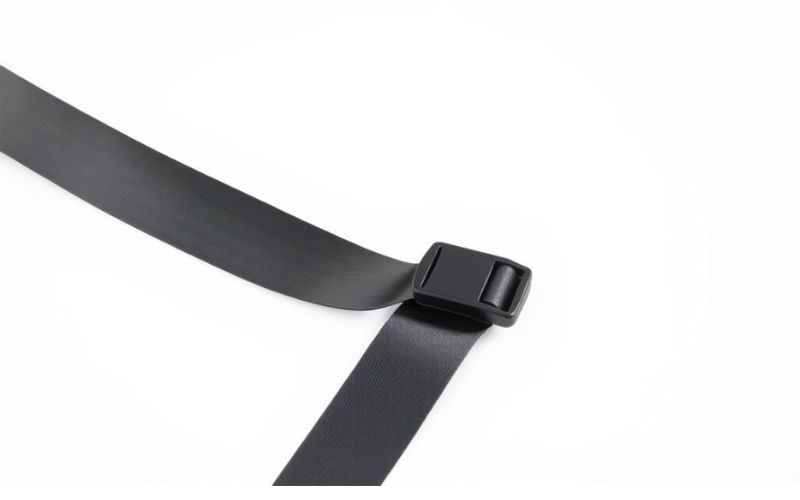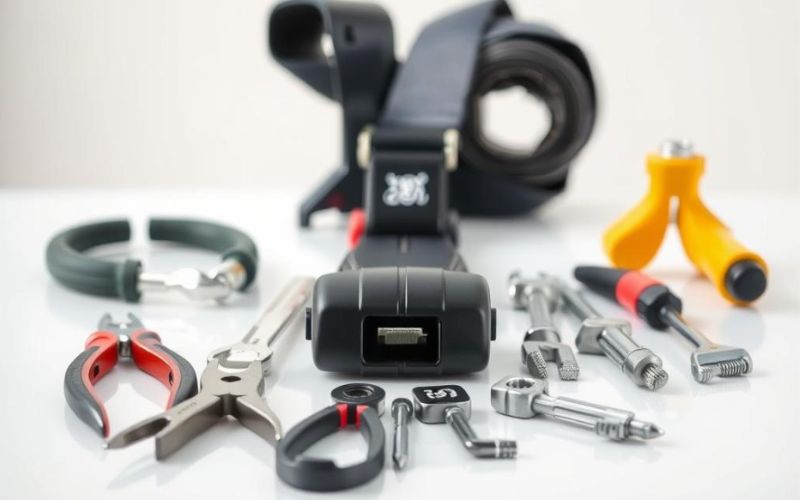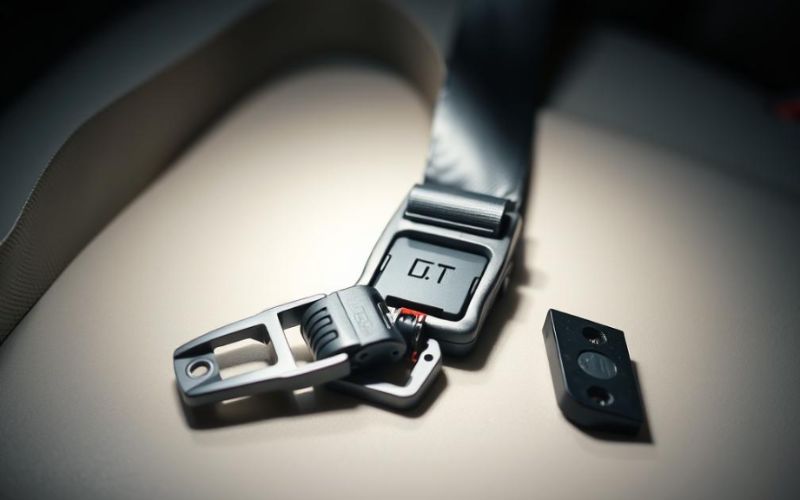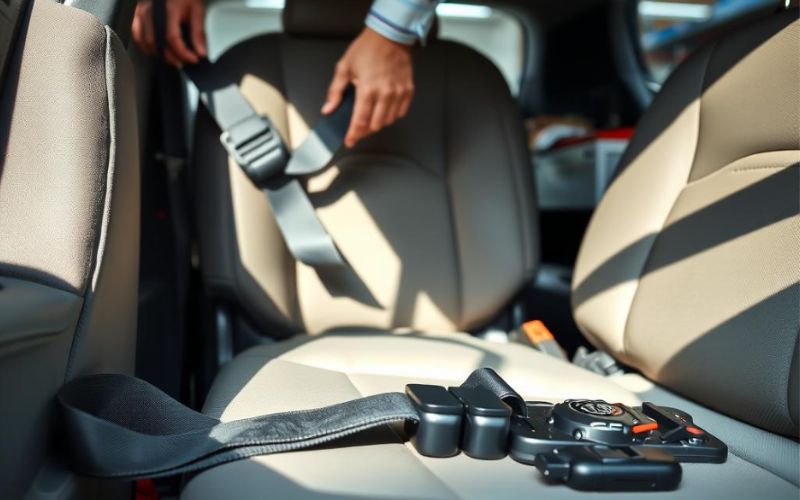Keeping your car safe is very important. It helps protect you and your family when driving. Checking your car’s safety features is key.
It’s easy to forget about your car’s safety belts until you have a problem. But, old or broken belts can really up the risk of getting hurt in an accident. Replacing them is simple and makes your car much safer.
With a few easy steps, you can make sure your car’s belts work right. This gives you peace of mind while you’re driving.
Topic Summary
- Understanding Car Seat Belts and When to Replace Them
- Tools and Materials Needed For Seat Belt Replacement
- Preparing For The Replacement Process
- Complete Car Seat Belt Replacement Process
- Removing The Old Seat Belt
- Detaching The Retractor Mechanism
- Removing Anchor Points
- Handling The Buckle Assembly
- Installing the New Seat Belt
- Mounting The Retractor
- Securing Anchor Points
- Attaching The Buckle Assembly
- Routing The Belt Correctly
- Vehicle-Specific Considerations
- Sedan and Coupe Installations
- SUV and Truck Differences
- Troubleshooting Common Installation Issues
- Ensuring Car Safety Through Proper Seat Belt Replacement
- FAQs on How To Replace Car Seat Belts: Step-by-Step Guide
- How Often Should I inspect My Car’s Seat Belts For Damage or Wear?
- Can I Replace a Car Seat Belt Myself, or do I Need Professional Help?
- What Are The Signs That indicate My Car Seat Belt Needs to Be Replaced?
- Are There Different Types of Car Seat Belts, and How To I Know Which one to Replace With?
- Is it Necessary to Replace Both The Seat Belt and The Buckle, or Can I just Replace one?
- How Do I Ensure The New Seat Belt is installed Correctly?
- Can I Use a Used or Aftermarket Seat Belt Replacement?
- What Are The Legal implications of Having a Faulty or non-Functional Seat Belt?
Key Takeaways
- Regularly inspect your vehicle’s safety restraints for wear and damage.
- Understand the importance of replacing worn-out safety restraints.
- Follow a step-by-step guide to replace safety restraints effectively.
- Enhance your vehicle’s safety and protect yourself and your loved ones.
- Ensure proper functioning of safety restraints to minimize injury risk.
Understanding Car Seat Belts and When to Replace Them
It’s important to know how car seat belts work for your safety. They help keep you safe by holding you in place during sudden stops or accidents. This can greatly reduce the chance of getting hurt or worse.

Types of Car Seat Belts
There are different kinds of car seat belts. You might find lap belts, sash belts, or three-point belts. Three-point belts are the most common. They work by holding you across your pelvis and shoulder, making you safer.
Signs Your Seat Belts Need Replacement
Look out for signs that your seat belts need to be replaced. If you see fraying, cuts, or if the retractor doesn’t work right, it’s time to get new ones. Also, after an accident, even a small one, check your seat belts for damage and replace them if needed.
Legal Requirements For Seat Belt Functionality
Car owners must keep their seat belts working well. Laws about this vary by state. But, in general, your seat belts must be in good shape. If they’re damaged or not working, you need to fix them fast to avoid legal trouble and keep everyone safe.
It’s key to check and take care of your car’s seat belts regularly. Knowing about the different types, when to replace them, and following the law can make your car much safer.
Tools and Materials Needed For Seat Belt Replacement
Before starting to replace your car’s seat belts, gather the needed tools and materials. This step ensures a smooth and safe replacement.
Essential Tools For The Job
To replace your car’s seat belts well, you need basic tools. These include a socket set, Torx bits, and a wrench. The right tools help avoid damage to your vehicle.
Choosing The Right Replacement Seat Belts
Choosing the right seat belts is key for safety and function. Make sure the new belts fit your car’s make and model. Check your owner’s manual or ask a pro for help. opt for belts that meet or exceed OEM standards for safety.

When to Consider Professional Help
If you’re not sure about the replacement process, get professional help. A mechanic or seat belt service can guide you. They ensure the job is done right and safely.
| Tool/Material | Description | Importance Level |
| Socket Set | A set of sockets for removing bolts | High |
| Torx Bits | Specialized bits for Torx screws | High |
| Wrench | For tightening and loosening bolts | Medium |
| Replacement Seat Belts | New seat belts compatible with your vehicle | Critical |
Preparing For The Replacement Process
To make the replacement smooth and safe, you need to prepare. It’s key to understand how preparation keeps you safe and helps the installation succeed.
Safety Precautions Before Starting
Put on gloves and safety glasses before starting. Make sure your car is parked on a flat surface and the parking brake is on. This keeps you safe from accidents or injuries.
- Wear protective gloves and safety glasses
- Park on a level surface
- Apply the parking brake
Accessing The Seat Belt Assembly
To get to the seat belt assembly, you might need to remove parts like the seat or trim panels. Check your car’s repair manual for how to do this.

Documenting The Original Installation
It’s important to document the original installation. Take photos or notes on the seat belt’s path, where clips or fasteners are, and other details.
By following these steps, you can replace your vehicle’s seat belt safely and successfully.
Complete Car Seat Belt Replacement Process
Replacing a car seat belt is a detailed process. It ensures your vehicle’s safety features work well.
Removing The Old Seat Belt
To start, remove the old seat belt. This means taking apart the retractor, anchor points, and buckle.
Detaching The Retractor Mechanism
The retractor is in the rear seat or under the dashboard. First, release any tension in the belt. Then, unscrew the bolts.
Removing Anchor Points
Anchor points hold the seat belt to the frame. Use a wrench to loosen and remove the bolts. Keep the bolts safe for the new belt.
Handling The Buckle Assembly
The buckle is on the seat or floor. Remove the screws or bolts. Then, gently pull it away.

Installing the New Seat Belt
Now, install the new seat belt. Mount the retractor, secure anchor points, attach the buckle, and route the belt right.
Mounting The Retractor
Put the new retractor in its spot and screw it in. Make sure it’s tight.
Securing Anchor Points
Put the new anchor points in the old holes. Use the bolts you removed. Tighten them well.
Attaching The Buckle Assembly
Put the buckle back where it belongs. Use the same screws or bolts. Make sure it’s tight.
Routing The Belt Correctly
Make sure the belt goes through the right guides. Wrong routing can harm the belt’s performance.
Vehicle-Specific Considerations
Each vehicle has its own needs for seat belt replacement. Sedans and coupes differ from SUVs and trucks.
Sedan and Coupe Installations
Sedans and coupes have complex rear seat belt mounts. Be extra careful.
SUV and Truck Differences
SUVs and trucks have stronger seat belts. Make sure the new belt fits your vehicle.
Troubleshooting Common Installation Issues
Common problems include misaligned anchor points and loose bolts. Check your work well to avoid these.
“Proper installation of a seat belt is key for safety. Always check your vehicle’s manual for instructions.”
By following these steps and knowing your vehicle’s needs, you can replace your seat belt safely.
Ensuring Car Safety Through Proper Seat Belt Replacement
Replacing your car’s seat belts is key to keeping everyone safe. This article guides you through the steps. You’ll make sure your seat belts work right, keeping you and your passengers safe.
It’s not just about staying safe; it’s also the law. If you’re not sure how to replace them, get help from a pro. They’ll do it right and fast.
By focusing on car safety and keeping your seat belts in check, you’ll drive safer. You’ll also lower the chance of getting hurt in an accident.
FAQs on How To Replace Car Seat Belts: Step-by-Step Guide
How Often Should I inspect My Car’s Seat Belts For Damage or Wear?
Check your car’s seat belts every 12,000 to 15,000 miles. Or, follow your vehicle’s manufacturer advice. This keeps them working right.
Can I Replace a Car Seat Belt Myself, or do I Need Professional Help?
You can replace a seat belt yourself if you have the right tools. But, it’s safer to get help from a pro. This ensures your safety and the belt’s correct installation.
What Are The Signs That indicate My Car Seat Belt Needs to Be Replaced?
Look for wear, fraying, or damage on the belt. Also, if the retractor or buckle doesn’t work right. Or, if your car is recalled for a seat belt issue.
Are There Different Types of Car Seat Belts, and How To I Know Which one to Replace With?
Yes, there are different seat belts. Three-point, two-point, and lap belts are some examples. Check your car’s manual or contact the maker to find out what you need.
Is it Necessary to Replace Both The Seat Belt and The Buckle, or Can I just Replace one?
It’s best to replace the whole seat belt, including the buckle. This ensures everything works right together. But, some makers let you replace just the buckle if it’s damaged.
How Do I Ensure The New Seat Belt is installed Correctly?
Follow the maker’s instructions for installing the new seat belt. If you’re not sure, get help from a mechanic or auto tech. Correct installation is key for safety.
Can I Use a Used or Aftermarket Seat Belt Replacement?
It’s not wise to use a used or aftermarket seat belt. They might not be safe. Stick with OEM or certified parts for the best safety.
What Are The Legal implications of Having a Faulty or non-Functional Seat Belt?
A bad seat belt can lead to fines or failing vehicle checks. It also raises the risk of injury or death in an accident. Always keep your seat belts in good shape.

